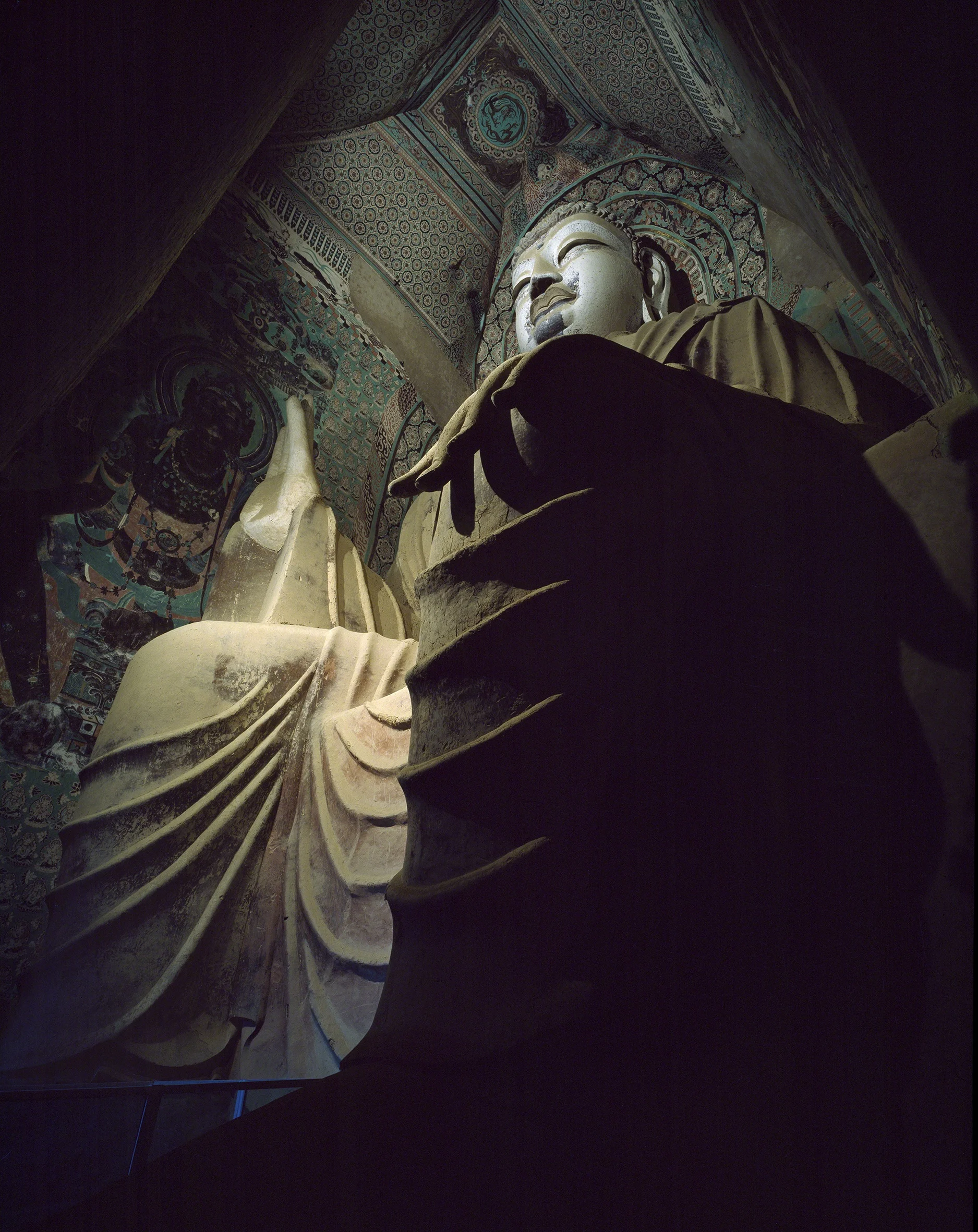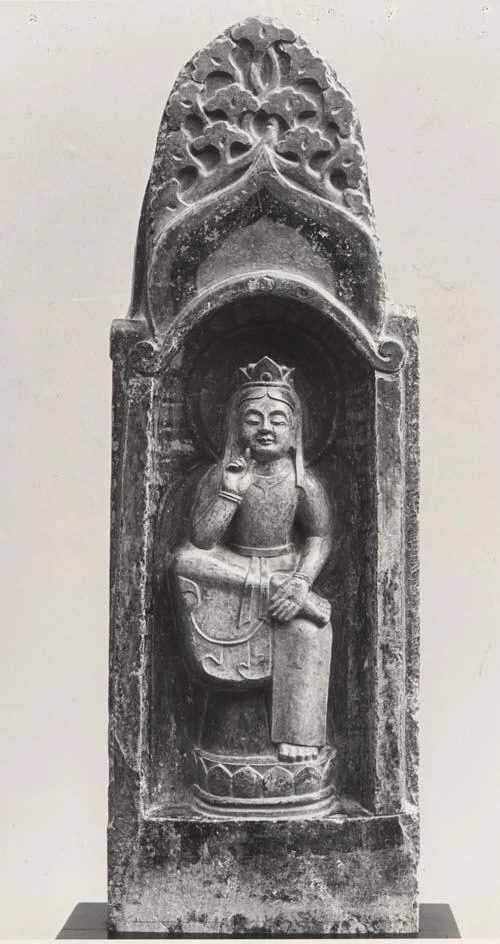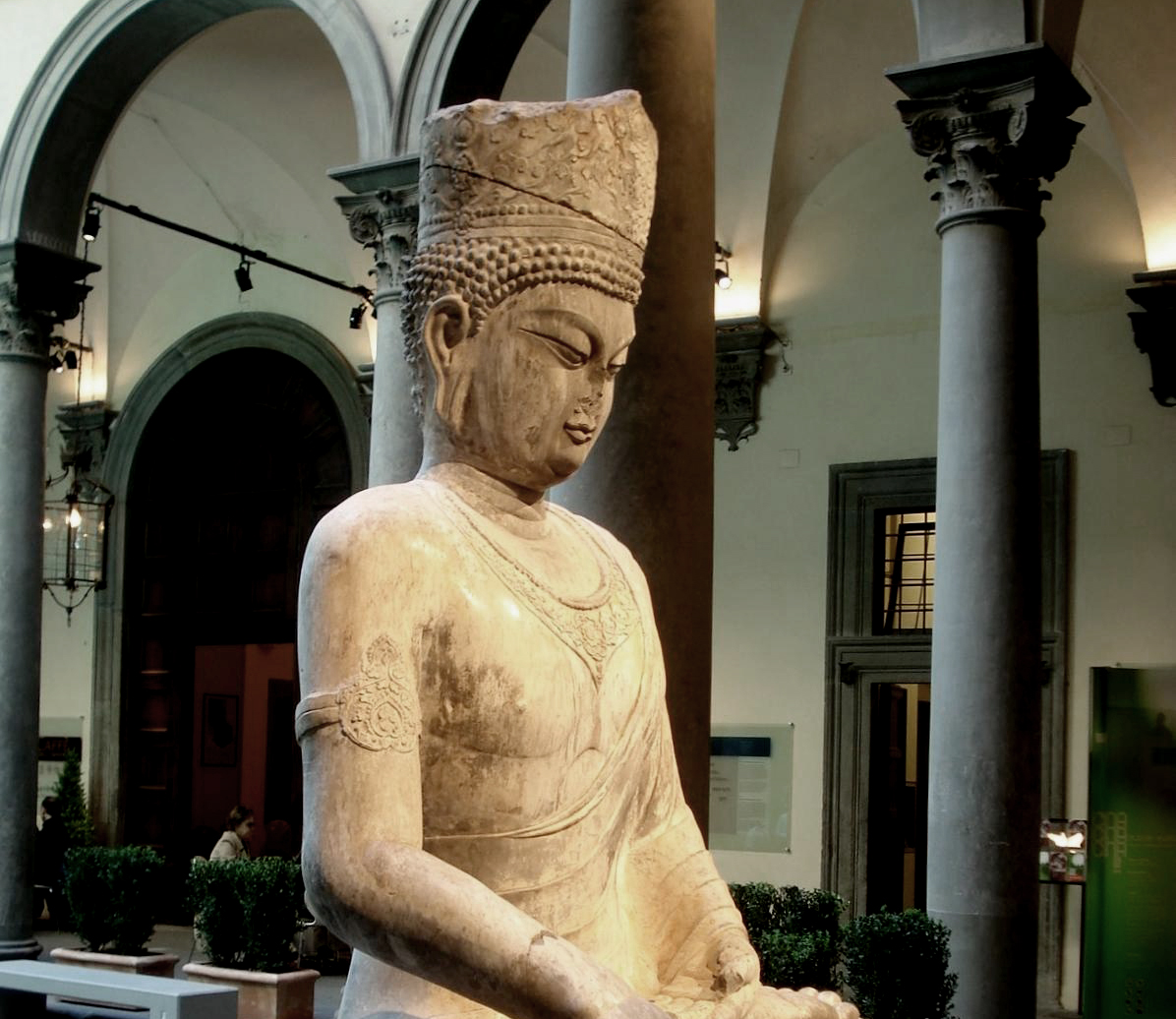The Southern Colossal Buddha Maitreya. Mogao Cave 96. 618-705 CE. High to Late Tang. China. Image Courtesy of the Dunhuang Academy.
Buddhism teaches that all the things surrounding us in life are impermanent. Love, money, happiness, pain, and even life itself are transient.
According to some Buddhist schools of thought, even Buddhism itself is transient. Its current teachings will one day be forgotten, to be replaced by a new Buddhism.
The Buddha Maitreya is the Buddha of the Future. Technically, the Maitreya is not yet a buddha, but is currently a bodhisattva who resides and waits in the Tuṣita Heaven. The Tuṣita Heaven is one of the realms in Buddhist cosmology known for being a place where deities and bodhisattvas are born before they each enter their last human life cycle and achieve final enlightenment as buddhas.
At Any Moment
Figure of Maitreya with Two Attendants. 5th Century. Northern Wei Dynasty. China. Image courtesy of The Met.
This Chinese portrayal of the Bodhisattva Maitreya depicts him sitting in a posture with one leg draped over the other. This is known as the "pensive" posture, and he is depicted as such because he can quickly stand and descend to earth at a moment's notice.
Wu Zetian
A 17th-century Chinese depiction of Wu, from Empress Wu of the Zhou, 1690. Wiki Commons.
Empress Wu Zetian (624-705 CE, Tang Dynasty) used the narrative of the Bodhisattva Maitreya to further her political agenda.
Empress Wu faced harsh criticisms as a female emperor, and many arguments against her were grounded in supernatural and spiritual reasons. When earthquakes or natural anomalies occurred, the court would seize the opportunity to declare that heaven and the earth were displeased by Empress Wu's feminine energy.
At the height of her power, Empress Wu declared herself the female incarnation of the Buddha Maitreya to assert her sovereignty. She called herself Emperor Shengshen (圣神), which translates to "Holy Spirit," or "God."
Statue of Vairocana Buddha, originally located in the grottoes of Longmen, carved in the likeness of Empress Wu Zetian during her reign.
Photo taken at the exhibition "China at the Court of the Emperors: Unknown Masterpieces from Han Tradition to Tang Elegance (25-907)" at the Palazzo Strozzi in 2008 by Wiki Commons user Harlock81.
During Empress Wu's reign, she commissioned large-scale Buddhist art such as statues of the Buddha carved in her own likeness. One such statue is the famous colossal Vairocana Buddha at the Longmen Grottoes in Luoyang, China.
The Vairocana Buddha represents the "first buddha," or the buddha from whom all other buddhas originate. The face of the Vairocana Buddha at the Longmen Grottoes in Luoyang was modeled on the features of Wu Zetian.
The Laughing Buddha
Another popular representation of the Maitreya can be found in the images of the Laughing Buddha, or Budai (布袋, "cloth sack"). Also known as Hotei in Japanese, the round, good-humored monk is often identified as the Future Buddha.
Hotei. Kanou Takanobu. 1616. Edo period. Japan. Image courtesy of The Met.
Hotei was probably a real historical figure who hailed from Zhejiang province.
A popular depiction of this incarnation of Maitreya is found in the final verse of the Ten Ox-Herding Verses. A young boy searches for his lost ox as a metaphor for seeking enlightenment. In the tenth and final verse, the young boy has found the ox and has returned home, and a portly stranger is introduced. Some readings interpret this older figure as the boy from the beginning of the poem:
He enters the city barefoot, with chest exposed;
Covered in dust and ashes, smiling broadly.
No need for the magic powers of the gods and immortals,
Just let the dead tree bloom again.
—Trans. Gen Sakamoto
Sanbo Zen Buddhist practitioner Kubota Jiun explains the depiction of Hotei in the visual representations of the tenth verse:
All pictures representing the tenth of the Ten Ox-Herding Pictures show a fellow named Hotei [ ? - 917, Zen monk in old China]. He is said to have had a big belly. His gut is big and his chest bare. He has a big bag and a staff. And perhaps he has been walking barefooted. The attitude of the dear old Hotei, who is said to be a manifestation of Bodhisattva Maitreya, was presumably as that depicted by this verse.
—Kubota [Akira] Ji'un (1932-), translated by J. Cusumano & Satō M.
The final line in this verse may also allude to how billions of years in the future, Maitreya will usher in the rebirth of a new Buddhism following the complete passing of its current form.
"Let the dead tree bloom again." What was once old will become new again.
Further Reading
Ancient History Encyclopedia: Wu Zetian
Buddhism now: The Ten Ox-Herding Songs
Huffington Post: Who is the Laughing Buddha? Zen's Artistic Heritage
Khan Academy: Longmen caves, Luoyang
The Met: A Pensive Treasure
Newsfinder: Hotei, Pu-Tai, Maitreya, all known as the Laughing Buddha by Fotopoulou Sophia
Smithsonian: The Demonization of Empress Wu
Terebess Online: Ten Ox-herding Pictures
ThoughtCo: Maitreya Buddha
Buswell, Robert E., Donald S. Lopez. The Princeton Dictionary of Buddhism. Princeton: Princeton University (2004).





